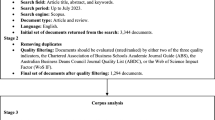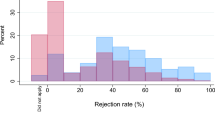Abstract
In this paper we use the additive efficiency decomposition approach in two-stage data envelopment analysis. Initially, we evaluate the variable returns to scale version and face a structural difficulty of the model. In an extreme case, weights ξ 1 or ξ 2, which represent the relative importance of the performance of the first and second stages, respectively, become zero for a number of decision making units (DMUs). As a result, individual stage efficiencies for these DMUs are undefined. We propose a weight assurance region model to restrict ξ 1 and ξ 2, which ensures that both weights are always positive, and therefore individual stage efficiency is always defined. Furthermore, the proposed model is appropriate for policy making in the presence of a priori information about the relative importance of each stage in the overall process. We employ the new model to evaluate the efficiency of secondary education in 65 countries and construct an overall ‘school efficiency’ index. In the first stage we measure the ‘learning environment efficiency’ and in the second we measure the ‘student’s performance efficiency’.

Similar content being viewed by others
References
Allen R and Thanassoulis E (2004). Improving envelopment in data envelopment analysis. European Journal of Operational Research 154 (2): 363–379.
Beasley JE (1990). Comparing university departments. Omega—International Journal of Management Science 18 (2): 171–183.
Beasley JE (1995). Determining teaching and research efficiencies. Journal of the Operational Research Society 46 (4): 441–452.
Bifulco R and Bretschneider S (2001). Estimating school efficiency: A comparison of methods using simulated data. Economics of Education Review 20 (5): 417–429.
Charnes A and Cooper WW (1962). Programming with linear fractional functionals. Naval Research Logistics Quarterly 9 (3–4): 181–185.
Charnes A, Cooper WW and Rhodes E (1978). Measuring the efficiency of decision making units. European Journal of Operational Research 2 (6): 429–444.
Charnes A, Cooper WW, Wei QL and Huang ZM (1989). Cone ratio data envelopment analysis and multi-objective programming. International Journal of Systems Science 20 (7): 1099–1118.
Chen Y, Cook WD, Li N and Zhu J (2008). Additive efficiency decomposition in two-stage DEA. In: Kendall JE (ed). Proceedings of the 39th Annual Meeting of the Decision Science Institute, Decision Science Institute; Baltimore.
Chen Y, Cook WD, Li N and Zhu J (2009). Additive efficiency decomposition in two-stage DEA. European Journal of Operational Research 196 (3): 1170–1176.
Cook WD, Liang L and Zhu J (2010). Measuring performance of two-stage network structures by DEA: A review and future perspective. Omega—International Journal of Management Science 38 (6): 423–430.
Dyson RG and Thanassoulis E (1988). Reducing weight flexibility in data envelopment analysis. Journal of the Operational Research Society 39 (6): 563–576.
Färe R and Grosskopf S (1996). Intertemporal Production Frontiers: With Dynamic DEA. Kluwer Academic Publishers: Boston.
Färe R and Karagiannis G (2013). The denominator rule for share-weighting aggregation, mimeo.
Färe R, Grosskopf S, Forsund FR, Hayes K and Heshmati A (2006). Measurement of productivity and quality in non-marketable services: With application to schools. Quality Assurance in Education 14 (1): 21–36.
Goldhaber DD, Brewer DJ and Anderson DJ (1999). A three-way error components analysis of educational productivity. Education Economics 7 (3): 199–208.
Grosskopf S and Moutray C (2001). Evaluating performance in Chicago public high schools in the wake of decentralization. Economics of Education Review 20 (1): 1–14.
Grosskopf S, Hayes KJ, Taylor LL and Weber WL (1999). Anticipating the consequences of school reform: A new use of DEA. Management Science 45 (4): 608–620.
Haelermans C and Ruggiero J (2013). Estimating technical and allocative efficiency in the public sector: A nonparametric analysis of Dutch schools. European Journal of Operational Research 227 (1): 174–181.
Halkos GE, Tzeremes NG and Kourtzidis SA (2014). A unified classification of two-stage DEA models. Surveys in Operations Research and Management Science 19 (1): 1–16.
Hanushek EA (1986). The economics of schooling: Production and efficiency in public schools. Journal of Economic Literature 24 (3): 1141–1177.
Hanushek EA (1992). The trade-off between child quantity and quality. Journal of Political Economy 100 (1): 84–117.
Ho M H-C, Liu JS, Lu W-M and Huang C-C (2013). A new perspective to explore the technology transfer efficiencies in US universities. Journal of Technology Transfer 39 (2): 247–275.
Jennings P and Greenberg M (2009). The prosocial classroom: Teacher social and emotional competence in relation to student and classroom outcomes. Review of Educational Research 79 (1): 491–525.
Joro T and Viitala E-J (2004). Weight-restricted DEA in action: From expert opinions to mathematical models. Journal of the Operational Research Society 55 (8): 814–821.
Kao C and Hwang S (2008). Efficiency decomposition in two-stage data envelopment analysis: An application to non-life insurance companies in Taiwan. European Journal of Operations Research 185 (1): 418–429.
Lu WM (2012). Intellectual capital and university performance in Taiwan. Economic Modelling 29 (4): 1081–1089.
OECD (2010a). PISA 2009 results: What makes a school successful?—Resources, policies and practices (Volume IV), http://dx.doi.org/10.1787/9789264091559-en.
OECD (2010b). PISA 2009 results: What students know and can do—Student performance in reading, mathematics and science (Volume I). http://dx.doi.org/10.1787/9789264091450-en.
Podinovski VV and Athanassopoulos AD (1998). Assessing the relative efficiency of decision making units using DEA models with weight restrictions. Journal of the Operational Research Society 49 (5): 500–508.
Portela M and Thanassoulis E (2001). Decomposing school and school-type efficiency. European Journal of Operational Research 132 (2): 357–373.
Ramsden P (1991). A performance indicator of teaching quality in higher education: The course experience questionnaire. Studies in Higher Education 16 (2): 129–150.
Sarkis J (2000). A comparative analysis of DEA as a discrete alternative multiple criteria decision tool. European Journal of Operational Research 123 (3): 543–557.
Seiford M and Zhu J (1999). Profitability and marketability of the top 55 U.S. commercial banks. Management Science 45 (9): 1270–1288.
Thanassoulis E and Allen R (1998). Simulating weights restrictions in data envelopment analysis by means of unobserved DMUs. Management Science 44 (4): 586–594.
Thanassoulis E, Da Conceicao M and Portela SA (2002). School outcomes: Sharing the responsibility between pupil and school. Education Economics 10 (2): 183–207.
Thanassoulis E, Portela M and Allen R (2004). Incorporating value judgments in DEA. In: Cooper WW, Seiford L and Zhu J (eds). Handbook on Data Envelopment Analysis. Kluwer Academic Publishers: New York, Boston, Dordrecht, London, Moscow.
Thanassoulis E, Portela M and Despic O (2008). The mathematical programming approach to efficiency analysis. In: Fried H, Lovell K and Schmidt S (eds). Measurement of Productive Efficiency and Productivity Growth. Oxford University Press: New York.
Thanassoulis E, Kortelainen M and Allen R (2012). Improving envelopment in data envelopment analysis under variable returns to scale. European Journal of Operational Research 218 (1): 175–185.
Thompson RG, Langemeier LN, Lee E and Thrall RM (1990). The role of multiplier bounds in efficiency analysis with application to Kansas farming. Journal of Econometrics 46 (1–2): 93–108.
Wang CH, Gopal RD and Zionts S (1997). Use of data envelopment analysis in assessing information technology impact on firm performance. Annals of Operations Research 73 (1): 191–213.
Woessmann L (2011). Cross-country evidence on teacher performance pay. Economics of Education Review 30 (3): 404–418.
Wong Y-H B and Beasley JE (1990). Restricting weight flexibility in data envelopment analysis. Journal of the Operational Research Society 41 (9): 829–835.
Zhu J (1996). Data envelopment analysis with preference structure. Journal of the Operational Research Society 47 (1): 136–150.
Acknowledgements
We thank three anonymous reviewers for their useful comments made on earlier versions of the paper. In addition, we thank Rolf Färe, Giannis Karagiannis, Emmanuel Thanassoulis and the other members of the Workshop on ‘Efficiency in Higher Education’ that took place on 24–25 June at the University of Macedonia, Thessaloniki, Greece for the comments made on an earlier version of the paper.
Author information
Authors and Affiliations
Corresponding author
Appendix
Appendix
Proof
-
The transformation of the restriction (6) into the last two constraints in model (7) can be obtained as:

From the left-hand side of (A.1):

And from the right-hand side of (A.1):

Then we incorporate constraints (A.2) and (A.3) into model (3) resulting in model (7). □
Rights and permissions
About this article
Cite this article
Halkos, G., Tzeremes, N. & Kourtzidis, S. Weight assurance region in two-stage additive efficiency decomposition DEA model: an application to school data. J Oper Res Soc 66, 696–704 (2015). https://doi.org/10.1057/jors.2014.49
Received:
Accepted:
Published:
Issue Date:
DOI: https://doi.org/10.1057/jors.2014.49







